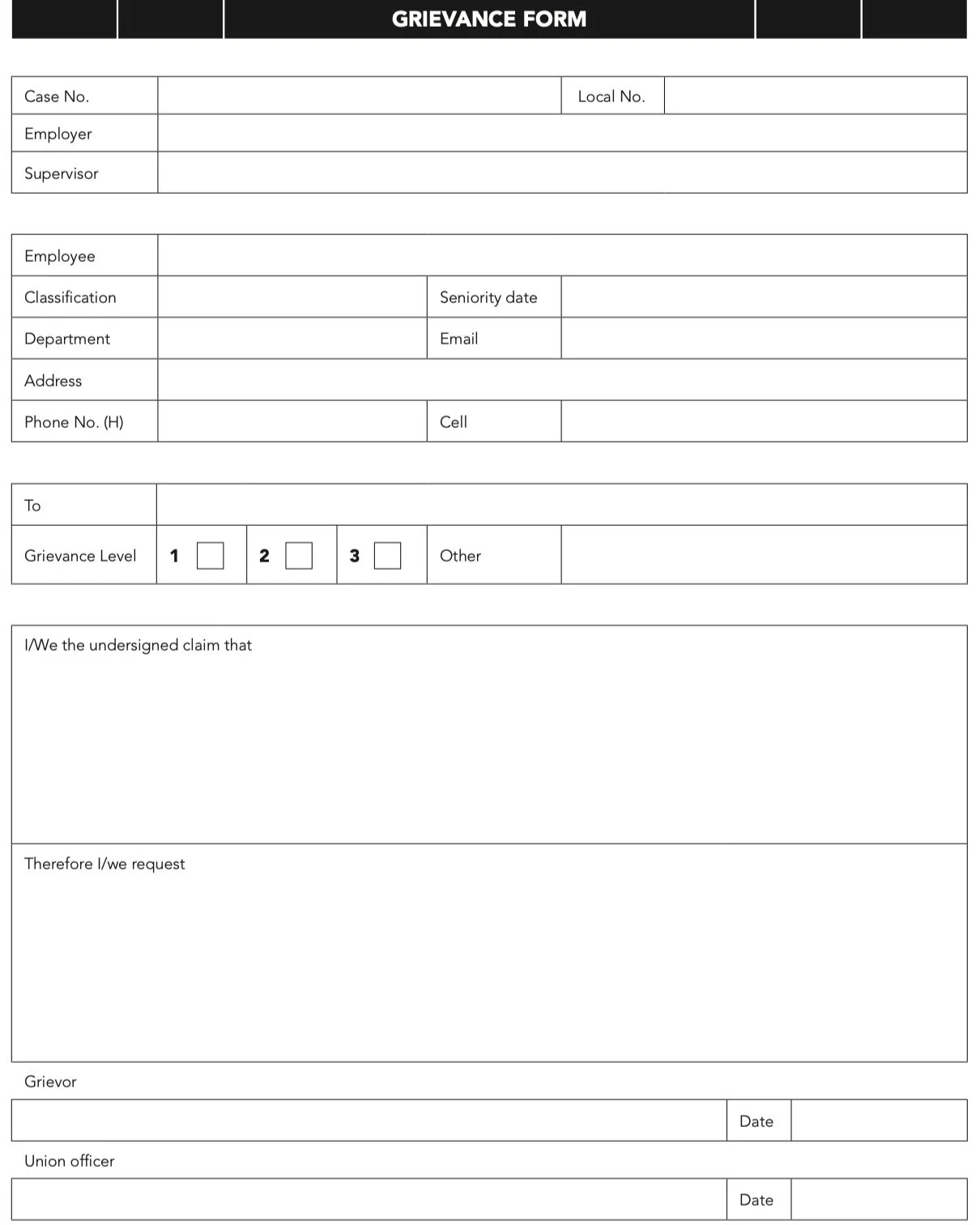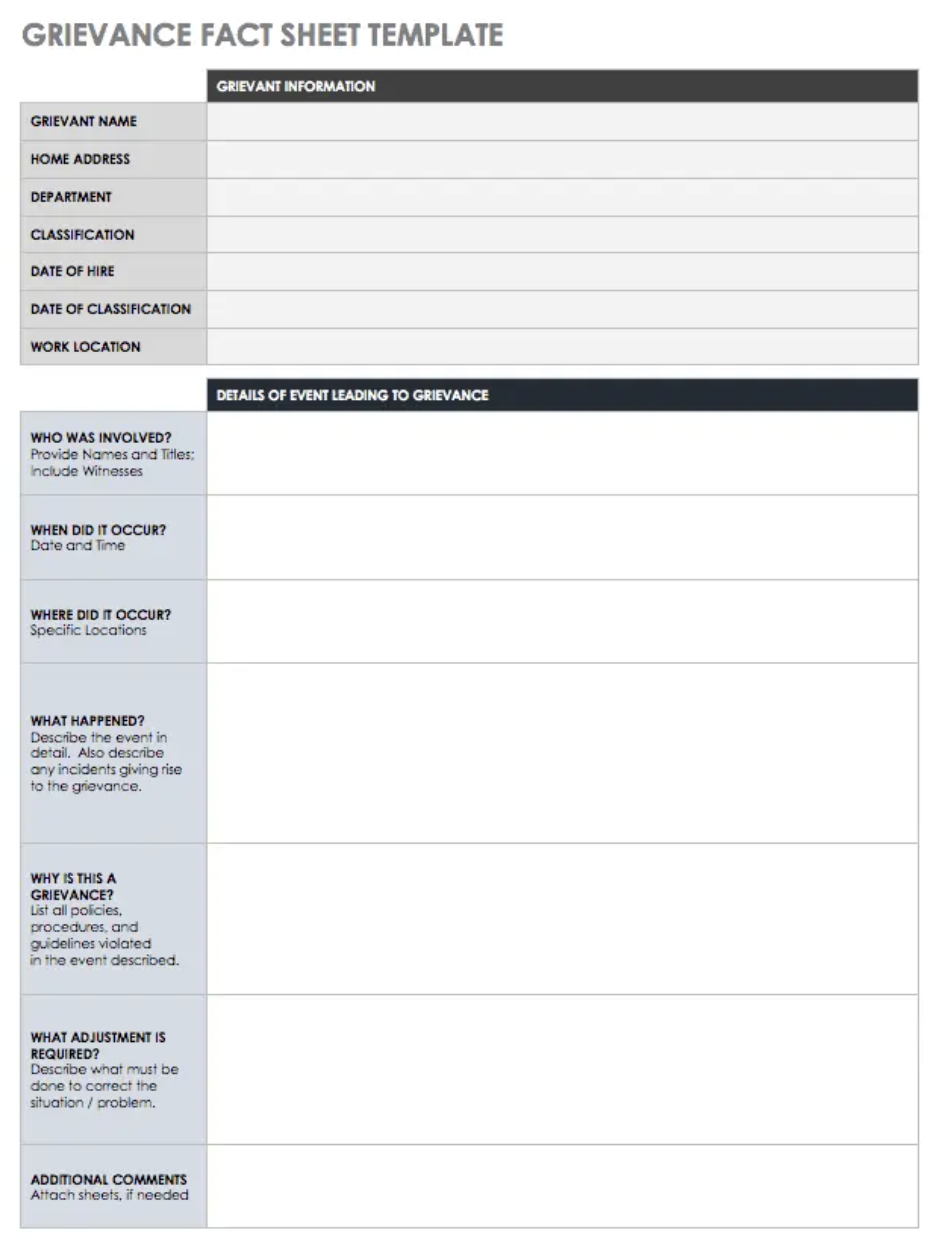Union Grievance Forms: Templates and Recommendations
If you are a member of a trade union you likely already know the importance of having union grievance forms that are user-friendly and easy to fill out.
Union grievance forms provide a structured format for documenting the details of a workplace complaint.
In this post, we go over what union grievance forms are, how to use them, and different design options to consider for your union.
Click on each corresponding link to jump ahead:
If you have any questions regarding union grievance forms or other print products for unions, contact JH French today.
For more information on the grievance process, check out our recent post: “Everything You Need to Know About Collective Agreements.”
Union Grievance Forms
An example of a standard union grievance form | Image source: Cupe.
What are Union Grievance Forms?
Union grievance forms are official documents used by labour unions to initiate a formal complaint or grievance on behalf of an employee or group of employees.
When a worker believes that their rights have been violated, such as an issue related to:
Workplace conditions,
Compensation,
Hours of work, or
Disciplinary actions.
They can file a grievance with their union.
If you are experiencing poor working conditions, file a grievance.
The purpose of a union grievance form is to provide a structured format for documenting the details of the complaint. The form typically includes sections where the employee can provide information such as their:
Name,
Job title,
Union affiliation, and
Contact details.
Additionally, the form will include fields to describe the nature of the grievance. This includes specific information pertaining to:
The alleged violation,
The parties involved,
Relevant dates, and
Any supporting evidence or documentation
By filling out a union grievance form, the employee is formally requesting the union to intervene on their behalf and address the issue through labour-management procedures established through documents like collective bargaining agreements or workplace policies.
The union grievance form is submitted to the union representative or steward responsible for handling grievances. It is then assessed and the appropriate course of action is decided on.
How Do You Use Union Grievance Forms?
Consider this general overview on how to use union grievance forms:
1. Obtain the form:
Union grievance forms are typically provided by the labour union representing the employees. You can request the form from your union representative, steward, or the union office.
2. Review the instructions:
Read the instructions or guidelines accompanying the grievance form carefully. They may provide specific information on how to fill out the form and what documentary evidence to include.
3. Fill out your information:
Begin by providing your personal details such as your name, employee identification number, job title, contact information, and union affiliation. Ensure this section is accurate and complete.
4. Describe the grievance:
Use the provided sections or fields to describe the nature of your grievance. Be clear and concise, providing specific details about the incident(s), violation(s), or issue(s) you are raising. Include relevant dates, times, locations, and any other information that supports your claim.
5. Identify the involved parties:
Clearly state the individuals or entities directly involved in the grievance. This may include supervisors, managers, coworkers, or the employer. Provide their names, job titles, and any other identifying information.
6. Attach supporting evidence:
If you have any supporting documents, such as emails, memos, policies, or witness statements, make copies and attach them to the grievance form. These materials can strengthen your case immensely by providing additional context for whoever is handling your union grievance form.
7. Sign and date the form:
Review the completed form to ensure accuracy and sign and date it. By signing, you are acknowledging the accuracy of the information provided and your request for the union to represent you.
8. Submit the form:
Submit the completed grievance form to the designated union representative, steward, or union official. Make sure you follow any specific instructions provided regarding submission methods (e.g., in-person, via email, mail, etc.).
Remember: It’s essential that you consult with your union representative or steward for guidance and clarification on how to use the grievance form effectively within your particular union’s procedures.
Now, let’s consider different design options for union grievance forms.
Design Options for Union Grievance Forms
The steps above on how to use a union grievance form may have provided you with some inspiration on what to include in a union grievance form. For instance, sections for:
Personal information (name, employee ID #, contact info, etc.),
Descriptions (dates, times, locations, etc.),
Signatures,
Dates, and
Instructions on how to complete the form
Should all be included on a union grievance form.
For further inspiration, consider the following design options from Smartsheet:
How you design your union grievance forms is entirely up to you, however, make sure they are organized well and easy to follow.
Check out the following resources for free grievance form templates:
If your union is in need of formal, well-structured grievance forms, read on for helpful tips that will make your forms more user-friendly and professional and contact JH French today!
1. Checkboxes and options:
Use checkboxes or multiple-choice options to make it easier for employees to specify the type of grievance, desired outcome, or preferred resolution method.
2. Confidentiality statement:
Consider adding a statement ensuring the confidentiality of the information provided and explaining how the union will handle sensitive information. This will make the complainant feel more comfortable through the grievance process.
3. Header:
Include a header section with the name and logo/union bug of the labour union responsible for the form. For example:
4. Bilingual options:
If applicable, provide bilingual versions of the form to accommodate employees who may have limited proficiency in the primary language used.
If you have any questions about what to include on your union grievance forms, how to design them, or you are looking to print a large amount of these forms, contact the union printing experts at JH French.
Union Printing With JH French
For insightful advice, decades of experience, and renowned customer service, get in touch with the print experts at JH French to help you print union grievance forms and other union documents.
We offer a wide selection of products and services to meet every need.
To learn more about the printing industry, check out our blog or call us directly.
Testimonials
“Highly recommend! They are so patient and accommodating - I came at them with some unrealistic timelines and they not only met our goal, but made it stress-free. They do fantastic work with 5-star customer service!”









